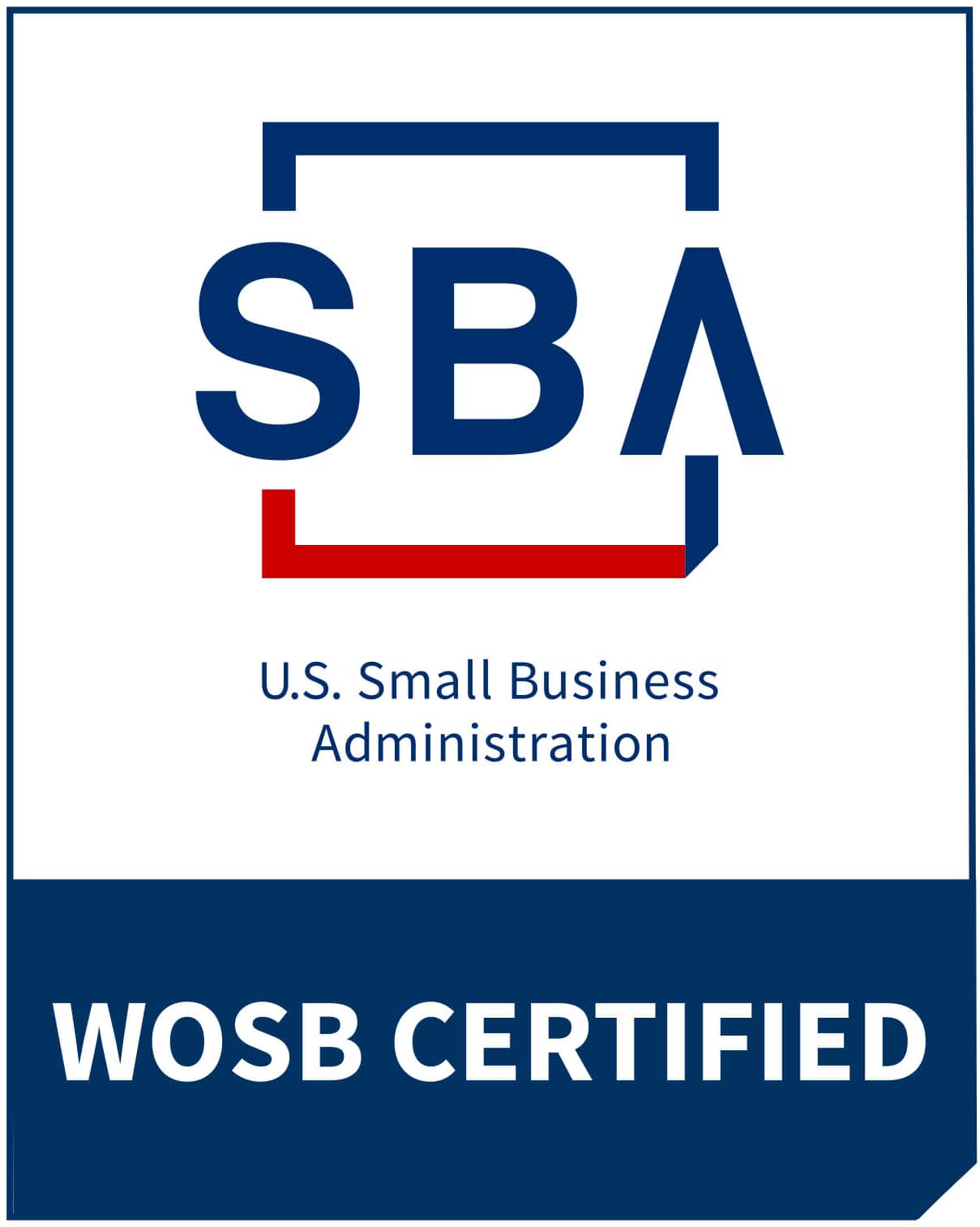Effective Performance Improvement Plan Example Templates

If you’re a manager, you know that having difficult conversations is part of the job. But knowing that doesn’t necessarily make it easier. One of the most challenging topics to cover is dealing with an employee with performance issues.
You need to maintain the balance between empathy and accountability. At the same time, you must be able to approach the issue with a sense of urgency while maintaining fairness and professionalism. A Performance Improvement Plan (PIP) can be an invaluable tool in achieving this balance.
Let’s explore what a PIP is and why it’s important. We’ll also provide performance improvement plan example templates you can use as-is or customize to fit your team’s needs.
What is a Performance Improvement Plan?
A Performance Improvement Plan, or PIP, is a document that addresses specific areas where an employee’s performance needs improvement. This document should outline the following:
- Area/s of improvement: This refers to the performance issues or behaviors that need to be addressed.
- Clear goals: Measurable objectives that the employees need to achieve.
- Timelines: A defined period for completing the plan (e.g., 30, 60, or 90 days)
- Resources and support: The tools, training, or guidance that will be provided for the employee’s improvement.
- Follow-up and evaluation: These are regular check-ins to track progress and provide feedback. A final evaluation must be done at the end of the specified time period to determine whether the employee has met the performance goals outlined in the plan.
When used correctly, a PIP clarifies and reinforces performance expectations. It also offers employees the opportunity and support they need to succeed in their role.
Looking for more virtual staffing best practices? Check out our Virtual Staffing 101 articles or schedule a free consultation call with our team for more information.
Why do you need a PIP?
A well-developed PIP helps create a fair, structured, and constructive approach to managing employee performance. It helps both managers and employees stay aligned on expectations. It provides clarity on how to address performance gaps instead of resorting immediately to disciplinary actions.
Here’s why implementing a PIP is important:
-
Encourages employee growth
A performance plan provides employees with a clear understanding of where improvement is needed and how to achieve it. It encourages employees to invest time and energy in their professional and personal development, with guidance and support from management, of course.
-
Promotes transparency and accountability
A PIP serves as a documented agreement between the manager and the employee. Because the plan is accessible to and discussed by both parties, it ensures transparency in expectations, timelines, and action steps. This document fosters accountability with both sides being aware of what needs to be done, when, and how progress will be measured.
-
Improves team performance
The saying, “A chain is only as strong as its weakest link,” applies to business settings as well. When you help individuals improve and perform their scope of work better, the whole team benefits. A successful PIP not only helps ease the workload and reduce stress. It can also inspire other team members to focus on their own professional growth and contribution.
-
Opens up conversation for alternatives
Of course, not every PIP will lead to the best-case scenario (i.e., your employee improving and meeting the goals set in the PIP). But it can open the door for honest discussions about potential solutions such as additional training, changes in workload, or even reassignment to a better-suited role.
-
Protects the organization
From an HR and labor compliance perspective, a PIP serves as formal documentation that the company has provided fair support and opportunities for improvement. It shows that the organization has made sufficient effort in helping the concerned employee improve before taking further actions.
In essence, a PIP isn’t just about fixing performance issues. It’s a practice that can foster a culture of continuous improvement and openness to feedback in the workplace.
Need help building your VA team? Whether you need virtual administrative support, IT assistance, or virtual marketing experts, our team of remote staffing experts can find the best fit VA you need. Simply book a free consultation call to get started.
What are the components of a Performance Improvement Plan?
A comprehensive PIP must include the following components:
-
The basics – employee details
A PIP is highly personalized. It’s developed specifically for the employee whose performance needs improvement. This section should include key details, such as:
- Employee name
- Job title
- Department
- Immediate supervisor or line manager
- Start date of the plan
- End date of the plan
Including these details enables clarity and proper documentation. Doing so makes the plan easier to locate and reference throughout the evaluation period.
-
Areas of improvement
Of course, not every PIP will lead to the best-case scenario (i.e., your employee improving and meeting the goals set in the PIP). But it can open the door for honest discussions about potential solutions such as additional training, changes in workload, or even reassignment to a better-suited role.
-
Expectations of the organization
This part of the PIP should clearly outline the performance standards or goals that the organization expects the employee to meet in relation to the identified area or areas of improvement.
The expectations should be specific, measurable, and realistically achievable within the given timeframe. Setting clear and attainable goals helps ensure that both the employee and manager have a shared understanding of what success looks like.
-
Action plan
A PIP should have detailed steps that the employee must take to meet performance expectations. It also includes the support in the form of training, tools, resources, and guidance that the manager and organization will provide.
It’s also best to include measurable milestones as well as a timeline for periodic check-ins before the final assessment. Checkpoints allow managers to provide timely feedback, recognize improvements, and discuss necessary adjustments to keep the employee on track toward achieving their goals.
-
Next steps or contingency
Every PIP has an end date, at which point a conclusion must be made based on the employee’s performance during the evaluation period. The next steps may vary depending on the results. If the employee has successfully met all the objectives, the plan can be deemed complete, and the employee can resume regular performance monitoring alongside their peers.
If there has been noticeable but incomplete progress, the manager may choose to extend the plan or provide additional support. However, if there is little to no improvement, it may be a sign for the organization to explore alternative actions. Examples of such alternatives include reassignment to a better-fitting role or, in some cases, more formal disciplinary measures.
Practical tips for managers
Creating and implementing a PIP requires care, structure, and consistent communication. Here are some practical tips that can help you manage the process effectively:
-
Be more proactive.
“Prevention is better than cure,” applies to people management, too. Instead of waiting for issues to worsen and needing to implement a PIP, it’s best to be proactive when cultivating a culture of ongoing improvement and open communication. Encourage regular feedback sessions, provide continuous coaching, and recognize achievements early. Doing so helps employees stay aligned with expectations and minimizes the need for formal corrective measures.
-
Focus on supporting, not punishing, employees.
A PIP is not a disciplinary memorandum, so the employee should never feel that it is. The goal is to provide structured support and directions to help employees succeed. Make sure to approach this process with a coaching or mentoring mindset, offering guidance, resources, and encouragement. This positive perception of a PIP makes it more likely for the employee to stay motivated and take an active role in their improvement.
-
Maintain open communication.
As a manager, make sure to encourage two-way dialogue when discussing the PIP. Additionally, the discussion should not end when the PIP document has been signed. Make sure to keep the conversation going throughout the improvement period to provide guidance, feedback, and support.
-
Be clear and specific.
Don’t leave room for misunderstanding or ambiguity. Clearly outline what needs to improve, why it matters, and what success looks like. Providing concrete examples and measurable goals will help the employee understand exactly what’s expected. A PIP should provide a clear roadmap for improvement, detailing the steps the employee needs to take and the resources available to support them.
-
Stay objective.
While empathy is a crucial trait for a manager, it’s important not to let emotional reactions or personal bias influence your PIP process. It’s best to remain objective—focus on facts and behaviors rather than personal opinions or assumptions.
-
Follow through with regular feedback and the final evaluation.
As a manager, it’s important to include regular check-ins in the PIP. These check-ins help monitor progress and provide constructive feedback. These ongoing discussions help keep the employee motivated and on track to reach the plan’s objectives.
Free download: Performance Improvement Plan examples
Here are some examples of Performance Improvement Plans (PIPs) to help you better understand how a PIP works in practice.
Sample Performance Improvement Plan #1
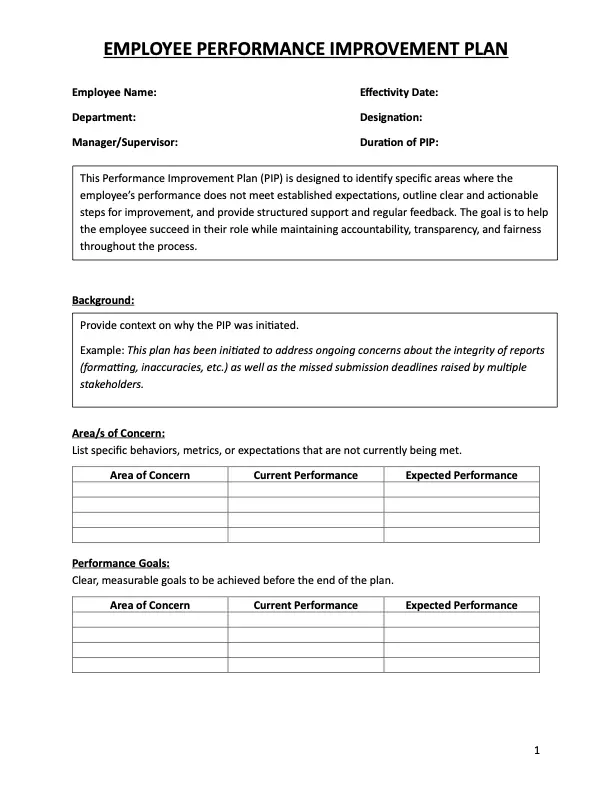
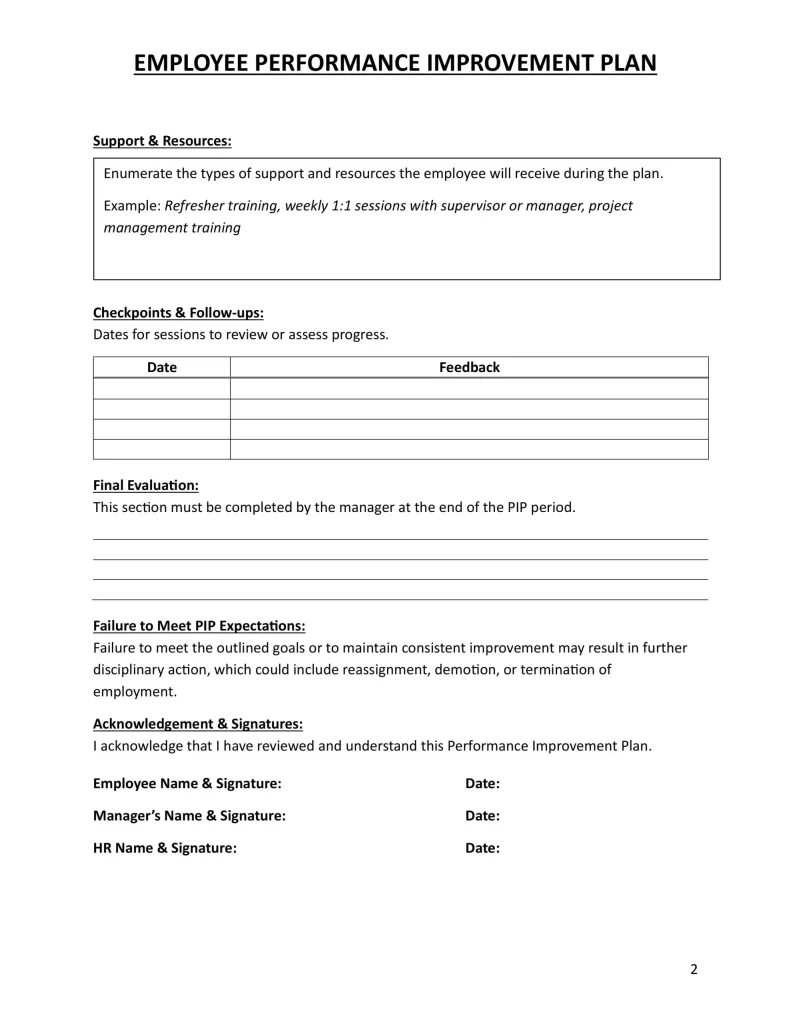
Sample Performance Improvement Plan #2
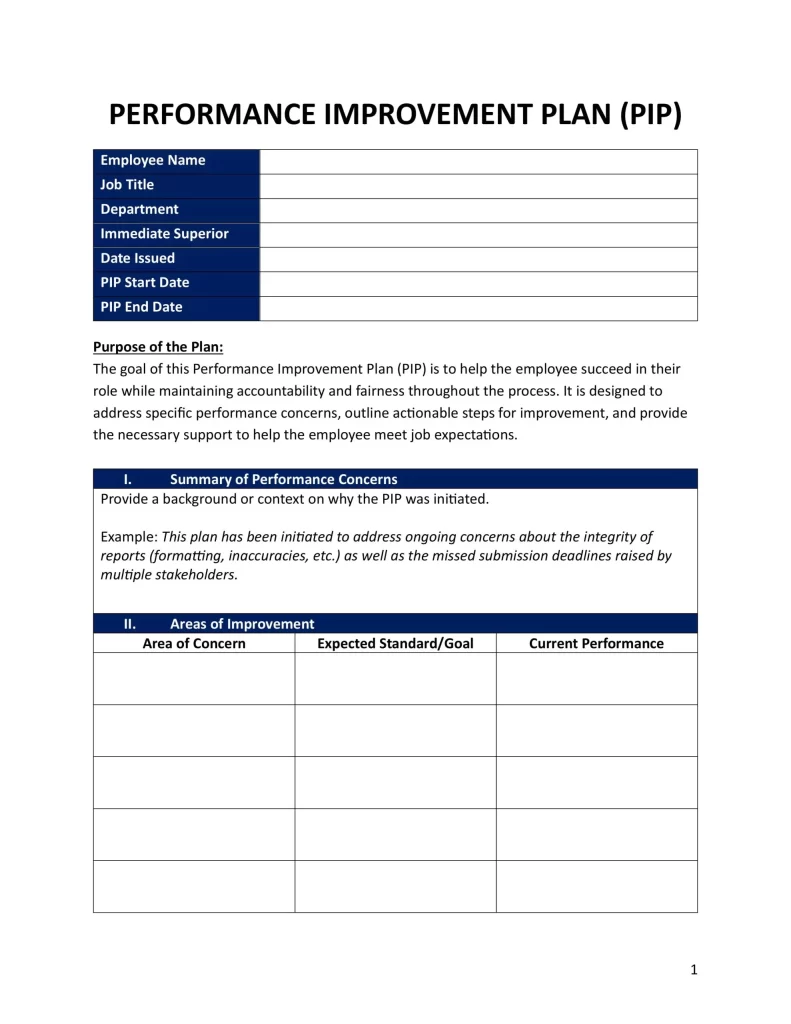
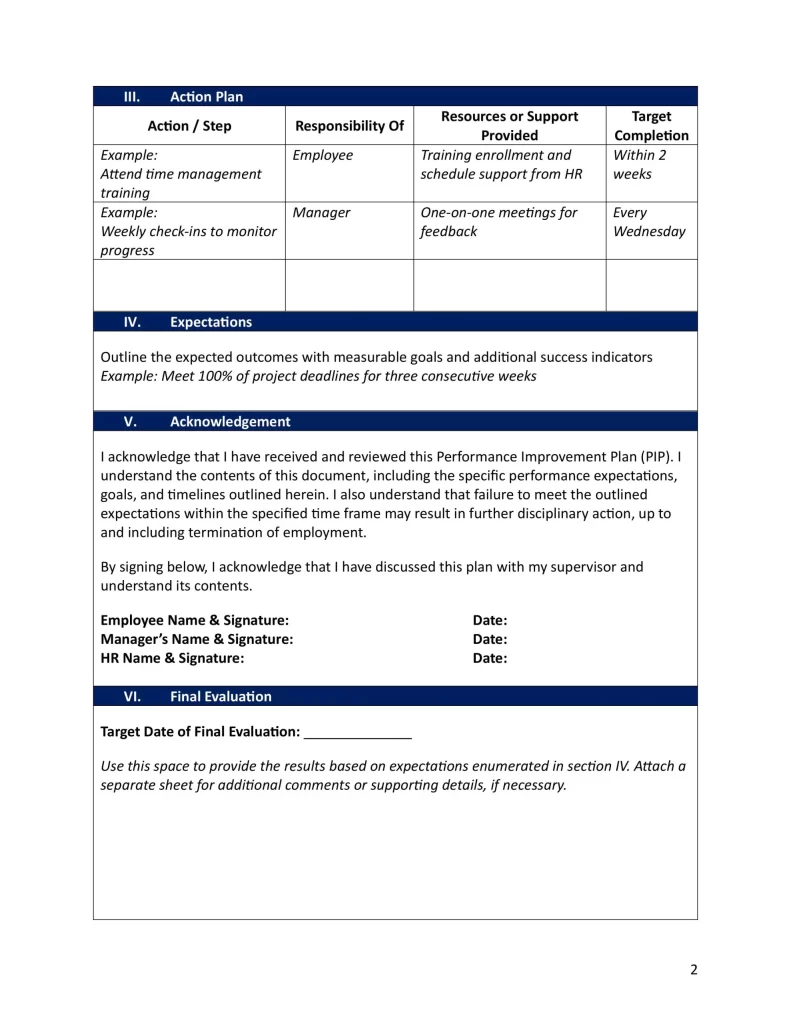
These sample PIP templates can serve as a starting point for managers seeking a constructive approach to addressing performance issues. When used thoughtfully, these templates can transform what might otherwise be a challenging conversation into an opportunity for growth and shared success.
Frequently Asked Questions (FAQs)
| How long should a Performance Improvement Plan last? | The duration of a PIP depends on the nature and severity of the performance issues. Shorter timelines (around 30 days) may work for more straightforward issues, while longer ones allow time for skill development and measurable progress. |
| How can I ensure the PIP process is fair and unbiased? | To keep the process fair, base your PIP on clear, documented performance data and maintain open communication with the employee throughout the improvement period. Avoid personal opinions and focus only on measurable behaviors and outcomes. Involving HR or another manager as a neutral reviewer can also help ensure fairness and consistency. |
| Can a PIP actually help retain employees? | Yes. When implemented with transparency and genuine support, a PIP can encourage growth and retention. It gives employees a structured opportunity to improve while showing that management is invested in their success—not just in penalizing poor performance. |
| Should I include HR in every Performance Improvement Plan? | Yes, it’s best practice to consult with HR when developing and executing a PIP. HR ensures the process follows company policy, complies with labor regulations, and maintains proper documentation in case further action is needed. |
| What should I do if the employee doesn’t meet the goals outlined in the PIP? | If an employee fails to meet the agreed-upon objectives, it’s important to review the process objectively. Evaluate whether the goals were realistic, whether adequate support was provided, and if there were any external factors that may have affected performance. Depending on the findings, next steps could include extending the PIP, reassigning the employee to a more suitable role, or initiating formal disciplinary action. |



